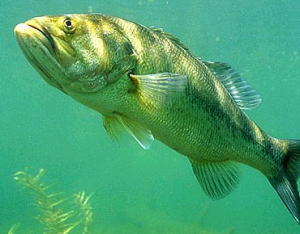Alien Species
Is Largemouth bass an "alien" ?
 Japan is the world's second-largest market for bass fishing. Japan is the world's second-largest market for bass fishing.As you may know, there are many fishing equipment manufacturers support this market. According to the Japan Sportsfishing Association association (JSA), about 3 million Japanese fish for Black bass, and market worth about 100 billion Japanese yen (=about US$1 billion). In Japan, black bass has been called a "nonnative species" or "alien species" ("Gairaigyo" in Japanese). |
||||||||||||||||||||||||||
| Photo by Eric Engbretson of Engbretson Underwater Photography: http//www.underwaterfishphotos.com |
||||||||||||||||||||||||||
Scientists and biologists consists that when nonnative species live in a habitat with native species, they may endanger native species in many different ways. And we need to reduce numbers of non-indigenous species because they endanger or cause problems for native species. Especially, Black bass and Bluegill are suppressing indigenous species like the Nigorobuna (Crucian carp) and Honmoroko (Carp), Tanago (Japanese bitterling), sources of Japanese popular cuisine. Nigorobuna is well-known as Funazushi (=a kind of "Sushi"). A measure taken under the pressure of necessity, some local governments began using gill nets from the late 1980 to try to eradicate growing numbers of both Largemouth bass and Bluegill. The Japanese government finally endorsed an ordinance to prohibit the importing and breeding of 37 nonnative species (including Black bass) seen as endangering the ecosystem and the law took effect from June 1, 2005. The law bans the importing, trading, breeding and disposing of designated alien species unless approved by the government for research or other special purposes. The industry groups, fishing federations, and anglers had insisted that banning the fish would hurt the industry, however, Black bass is finally officially branded as "invasive alien species" against their will. (The total number of public comment which against the law was over hundred thousand.) The invasive alien species act regulates: Invasive Alien Species (IAS): Official permission is required for importation Largemouth bass (Florida bass), Smallmouth bass, Bluegill, Channel catfish are categorized here Uncategorized Alien Species (UAS): Detailed investigation by the Japanese government is required before importation Living organisms required to have a certificate attached during their importation (LORCA): Official certificate issued by foreign government, etc. to verify its type is required for importation. The objectives of this act are to contribute to prevention of damages against biodiversity, human safety, or agriculture in Japan caused by invasive alien species.
Individual violators face fines of up to 30,000 Japanese yen (=about US$300) or up to 3 years in prison. The law imposes fines of up to 100,000,000 Japanese yen (=about US$100 million) on corporate violators. Releasing the designated species after catching them (based on "Catch and Release" concept) is not banned. Separately from the law, there are some local government independently bans to release "invasive alien species" once anglers caught. This means that "Catch and Kill" is he rule at these areas. The history of bass fishing in Japan isn't long as USA, but "Catch and Release" concept has taken root among anglers for 60 years of its history. "invasive alien species" in Japan
The regulation depends on prefectural and city governments, and you need to make sure if you have chance to come to Japan and go bass fishing. Largemouth bass are popular among anglers, and can be found in lakes and freshwater across the country. The lakes where Largemouth bass is stocked legally was only 4 lakes (Lake Ashinoko in Kanagawa / Lake Kawaguchi, Lake Yamanakako, Lake Saiko, in Yamanashi) where the bleeding of Largemouth bass is officially allowed as fisheries industry. The preservationists had believed that there are industry violate this and transport Largemouth bass and Bluegill organically to the lakes across the county only for their profit. Japan Sportsfishing Association association (JSA) opposed this suspicion. JSA insists that native species decreased is not caused not only by invasive foreign species, and but also due to the destruction of the natural environment. Revitalizing the environment from a broader perspective only leads us to the fundamental solution.
 There's many other places for freshwater fishing. Please feel free to contact us if you need any information on specific area, we'll get the information for you. The local government who bans "Catch and Release" are supported by the preservationists who are called "Black Bass Busters" or "Gairaigyo Basters". They're working on reducing "invasive alien species" populations with preventing their breeding, and removing "invasive alien species" themselves from the lake. The Environmental foundation, local fishery associations are leading the activities There's a group announced that they had removed (=killed) 5 tons of black bass and Bluegill in past 5 years. We can find some information about their Bass Busters Meeting in every weekend. It's not our intention to blame them on this page, but we'd like you to know that this is really happening in Japan these days. We also can't deny the fact that most of local fishery associations who originally lived by fishing of native species, eke out their living on the program supported by a grant from local governments who enhance to extermination of "invasive alien species". When I went fishing Largemouth first time was 6 years old, and I still remember that how exciting it was. I never thought things like this would happen to us. Right or wrong, removing alien species doesn't solve the problem. Japanese native fish "Koi (Koi Carp, aka Cyprinus carpio) becomes "invasive alien species" once they go outside of Japan. I think it's totally important to keep Japanese indigenous species, but still believe that "Catch and Release" should be brought down as culture of sportfishing to next generation as well. Special thanks to: Eric Engbretson of Engbretson Underwater Photography for great photos. You'll see more freshwater fish's photo at his web site is http://www.underwaterfishphotos.com Reference site for this article:
|
||||||||||||||||||||||||||








 Casey Roy
Casey Roy Steven Gregory
Steven Gregory Todd Wallace
Todd Wallace Stephane Bression
Stephane Bression Markus Schroder
Markus Schroder.jpg) Bruce Farina (Xpredator Lodge @Extremadura)
Bruce Farina (Xpredator Lodge @Extremadura)
















